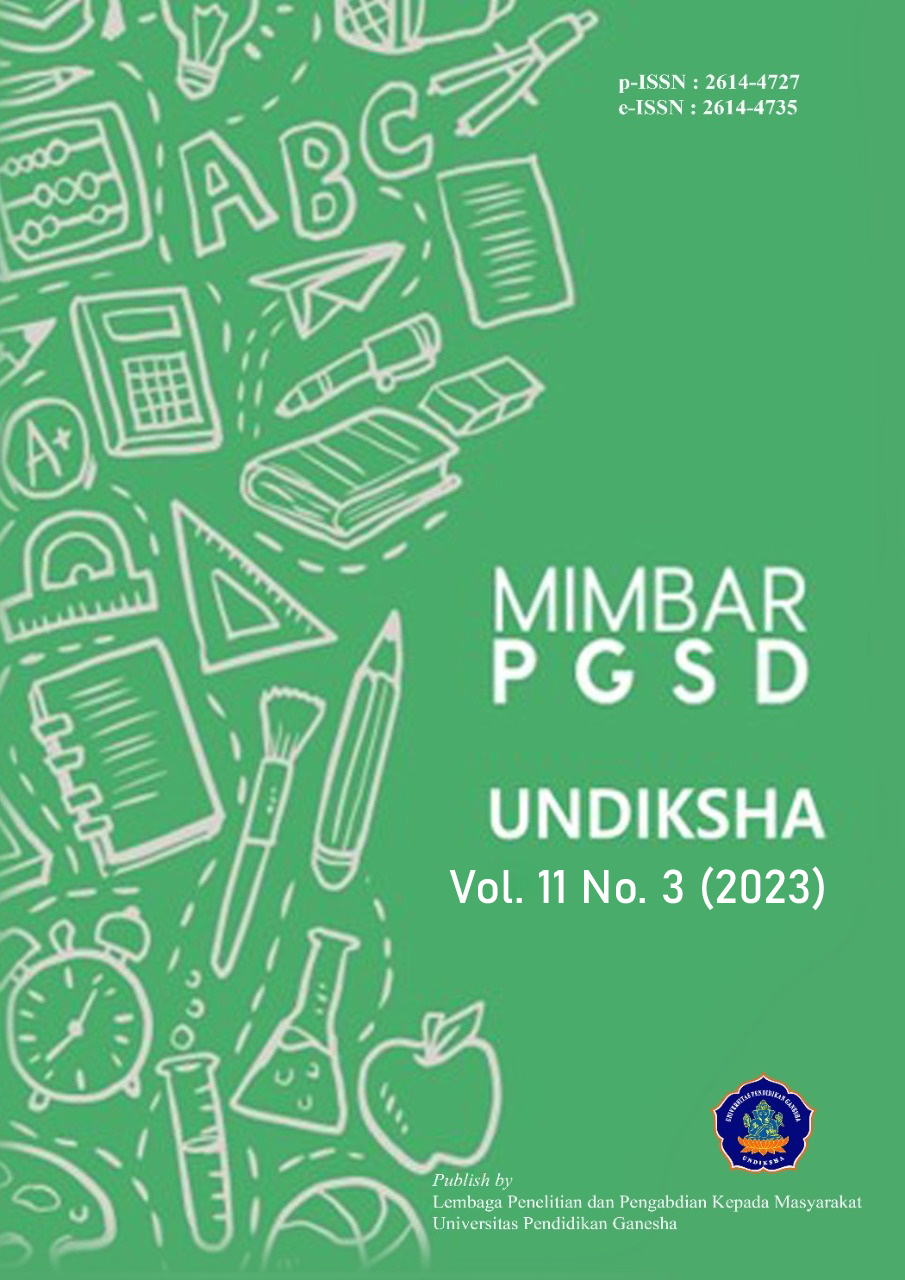Improving Elementary School Students' Understanding of Literacy and Numeracy Through Digital Applications
DOI:
https://doi.org/10.23887/jjpgsd.v11i3.64018Keywords:
Learning, Numeracy Literacy, Digital ApplicationsAbstract
The challenges of changing times require individuals to have adaptive life skills. Literacy and numeracy skills are two general skills that students need to have. The research aims to analyze elementary school (SD) students' understanding of literacy and numeracy through the use of digital applications in learning. Data collection was carried out through survey techniques using questionnaires, observations, and interviews. The participants in this study were 177 grade 4 (four) elementary school students, four teachers, and two school principals. Processing and analysis of data using descriptive quantitative analysis by combining the results of interviews and observations using a comprehensive analysis technique. The results showed that students' understanding of literacy material reached 39.32, and numeration material reached 34.81. On other aspects, based on the observation of the implementation of learning, it was found that 91% of teachers had delivered literacy and numeracy material in the excellent category. Based on the interviews and field observations, data was obtained that all sample schools had literacy and numeracy strengthening programs and carried them out regularly at school. Strengthening literacy and numeracy using digital application assistance in assessments in schools is currently unable to increase students' understanding of literacy and numeracy significantly.
References
Angriani, AD, Kusumayanti, A., & Yuliany, N. (2020). Development of Digital Book Learning Media on Algebra Material. Delta-Pi: Journal of Mathematics and Mathematics Education, 9(2), 13–30. https://doi.org/10.33387/dpi.v9i2.2244. DOI: https://doi.org/10.33387/dpi.v9i2.2244
Azhari, BM, Alifia Puteri, H., Azizah, I., Kamila, N., Azifatun Nazwa, H., & Andriatna, R. (2022). Efforts to Improve the Reading Literacy and Numeracy Skills of Elementary School Age Children in Jeron Village through Steam and Thinking Based Comic Worksheets. To Maega: Journal of Community Service, 5(2), 250. https://doi.org/10.35914/tomaega.v5i2.1058. DOI: https://doi.org/10.35914/tomaega.v5i2.1058
Canhoto, A.I., & Murphy, J. (2016). Learning From Simulation Design to Develop Better Experiential Learning Initiatives: An Integrative Approach. Journal of Marketing Education, 38(2). https://doi.org/10.1177/0273475316643746. DOI: https://doi.org/10.1177/0273475316643746
Creswell, W. J., & Creswell, J. D. (2018). Research Design: Qualitative, Quantitative and Mixed Methods Approaches. Journal of Chemical Information and Modeling, 53(9), 1–38. https://www.ucg.ac.me/skladiste/blog_609332/objava_105202/fajlovi/Creswell.pdf.
Ekowati, DW, Astuti, YP, Utami, IWP, Mukhlishina, I., & Suwandayani, BI (2019). Numeracy Literacy in Muhammadiyah Elementary Schools. ELSE (Elementary School Education Journal): Journal of Elementary School Education and Learning, 3(1), 93. https://doi.org/10.30651/else.v3i1.2541. DOI: https://doi.org/10.30651/else.v3i1.2541
Fatmawati, NI, & Sholikin, A. (2019). Digital Literacy, Educating Children in the Digital Era for Millennial Parents. Journal of Politics and Social Affairs, 11(2). https://doi.org/10.52166/madani.v11i2.3267.
Fauziah, F., Firman, F., & Ahmad, R. (2022). The Role of Guidance and Counseling Teachers in Implementing the Independent Learning Curriculum. Teacher Training: Journal of Research, Thought and Service, 10(2), 53–56. https://jurnal.uisu.ac.id/index.php/Keguruan/article/view/6452.
Fisabillillah, Y., & Rahmadanik, D. (2022). Implementation of the Application of Literacy and Numeracy in the Class 3 Teaching Campus at SDN 1 Kedungkumpul, Sukorame, Lamongan Regency. Community Development Journal: Journal of Community Service, 3(2), 876–883. https://doi.org/10.31004/cdj.v3i2.4879. DOI: https://doi.org/10.31004/cdj.v3i2.4879
Fitriyani, NN, Kusuma, RM, Supriadi, YN, Kusuma, JW, & Hamidah, H. (2022). PKM The Role of Teaching Campus Students 3 in Improving the Literacy and Numeracy of Students in Elementary Schools. International Journal of Community Service Learning, 6(2), 240–248. https://doi.org/10.23887/ijcsl.v6i2.51914. DOI: https://doi.org/10.23887/ijcsl.v6i2.51914
Ghofur, A., & Rachma, EA (2019). Utilization of Digital Media on the Lamongan Regency Community Reading Interest Index. Gulawentah: Journal of Social Studies, 4(2), 89. https://doi.org/10.25273/gulawentah.v4i2.5524. DOI: https://doi.org/10.25273/gulawentah.v4i2.5524
Hidayat, MNF, & Fawaid, A. (2023). PKM Improving Literacy, Numeracy and Technology Adaptation through the Teaching Campus Program at SMP Negeri 3 Pakuniran One Roof. Journal of Community Engagement, 4(1). https://doi.org/10.33650/guyub.v4i1.5928.
Ismafitri, R., Alfan, M., & Kusumaningrum, SR (2022). Characteristics of HOTS (High Order Thinking Skills) and Their Relationship with Numeracy Literacy Abilities in Elementary Schools. Journal of Educational Intervention Research, 4(1), 49–55. https://journal.rekarta.co.id/index.php/jrip/article/view/437.
Jannah, DRN, & Atmojo, IRW (2022). Digital Media in Empowering 21st Century Critical Thinking Skills in Science Learning in Elementary Schools. Basicedu Journal, 6(1), 1064–1074. https://doi.org/10.31004/basicedu.v6i1.2124. DOI: https://doi.org/10.31004/basicedu.v6i1.2124
Khasanah, F., Utami, RD, & Hartati, S. (2021). Application of Thematic Learning Based on Problem-Based Learning to Improve Learning Outcomes and Student Confidence. Journal of Integrated Elementary Education, 1(2). https://doi.org/10.21580/jieed.v1i2.9220. DOI: https://doi.org/10.21580/jieed.v1i2.9220
Kumala, FN, Nita, CIR, Yasa, AD, Ghufron, A., Pujiastuti, P., & Rahayu, CP (2021). Digital Literacy Analysis of Elementary-School Students in Malang. Proceedings of the 2nd Annual Conference on Social Science and Humanities (ANCOSH 2020), 542. https://doi.org/10.2991/assehr.k.210413.030. DOI: https://doi.org/10.2991/assehr.k.210413.030
Laksita, A., & Mawardi, M. (2023). Evaluation of the School Literacy Movement Program in Elementary Schools. Pulpit PGSD Undiksha, 11(1), 110–120. https://doi.org/10.23887/jjpgsd.v11i1.42891.
Maxwell, S., Reynolds, K. J., Lee, E., Subasic, E., & Bromhead, D. (2017). The impact of school climate and school identification on academic achievement: Multilevel modeling with student and teacher data. Frontiers in Psychology, 8(1). https://doi.org/10.3389/fpsyg.2017.02069. DOI: https://doi.org/10.3389/fpsyg.2017.02069
Muliantara, IK, & Suarni, NK (2022). Strategy to Strengthen Literacy and Numeracy to Support Independent Learning in Elementary Schools. Educative: Journal of Educational Sciences, 4(3). https://doi.org/10.31004/edukatif.v4i3.2847. DOI: https://doi.org/10.31004/edukatif.v4i3.2847
Munawar, B., Hasyim, AF, & Ma'arif, M. (2020). Digital Teaching Material Development Design Assisted by the Animaker Application. Golden Age Journal, 4(2), 310–320. https://doi.org/10.29408/goldenage.v4i02.2473. DOI: https://doi.org/10.29408/jga.v4i02.2473
Musoffa, M. (2022). Learning loss and decline in literacy and numeracy competency of elementary school (SD) students in Cikeusik sub-district, Pandeglang district, Banten. Journal of Islamic Education, 1(1). https://sinta.kemdikbud.go.id/journals/google/8211.
Musyafak, A., & Agoestanto, A. (2022). Development of Statistics Teaching Materials Containing Numeracy Literacy Questions with STEM Nuances to Improve Students' Critical Thinking Ability in PBL. Tadris Journal of Mathematics, 5(2), 273–284. https://doi.org/10.21274/jtm.2022.5.2.273-284. DOI: https://doi.org/10.21274/jtm.2022.5.2.273-284
Novrianti, NN (2018). Computer Based Learning E-Module as a Digital Literacy E-Resource for Students. Journal of Educational Studies, 3(1), 58. https://doi.org/10.30983/educative.v3i1.646. DOI: https://doi.org/10.30983/educative.v3i1.646
Nur, L., Nurani, L.A., Suryana, D., & Ahmad, A. (2020). Rasch Model Application on Character Development Instrument for Elementary School Students. International Journal of Learning, Teaching and Educational Research, 19(3), 437–459. https://doi.org/10.26803/ijlter.19.3.24. DOI: https://doi.org/10.26803/ijlter.19.3.24
Perdana, R., & Suswandari, M. (2021). Numeracy Literacy in Thematic Learning of Upper Grade Elementary School Students. Abscissa: Mathematics Education Journal, 3(1), 9. https://doi.org/10.32585/absis.v3i1.1385. DOI: https://doi.org/10.32585/absis.v3i1.1385
Priyanto, D., & Dharin, A. (2021). Students Creativity Development Model and Its Implementation in Indonesian Islamic Elementary School. Pegem Egitim ve Ogretim Dergisi, 11(3). https://www.pegegog.net/index.php/pegegog/article/view/1318.
Rohim, DC, & Rahmawati, S. (2020). The Role of Literacy in Increasing Students' Interest in Reading in Elementary Schools. Basic Education Review Journal: Journal of Educational Studies and Research Results, 6(3), 230–237. https://doi.org/10.26740/jrpd.v6n3.p230-237. DOI: https://doi.org/10.26740/jrpd.v6n3.p230-237
Salma, A. (2019). Analysis of the School Literacy Movement on Elementary School Students' Interest in Reading. Pulpit PGSD Undiksha, 7(2), 122–127. https://doi.org/10.23887/jjpgsd.v7i2.17555.
Saparuddin, S., & Kaswar, AB (2022). Training to Improve Skills in Making Microlearning Based Learning Videos using the Bandicam and Filmora Applications. Sasambo: Jurnal Abdimas (Journal of Community Service), 4(4), 638–647. https://doi.org/10.36312/sasambo.v4i4.924. DOI: https://doi.org/10.36312/sasambo.v4i4.924
Shabrina, L.M. (2022). Campus Teaching Activities to Improve Literacy and Numeracy Skills of Elementary School Students. Basicedu Journal, 6(1), 916–924. https://doi.org/10.31004/basicedu.v6i1.2041. DOI: https://doi.org/10.31004/basicedu.v6i1.2041
Triawang, G., & Kurniawan, E. (2021). The Effect of Digital Literacy Towards the Selection of Social Science Teacher Learning Media. Pegem Egitim ve Ogretim Dergisi, 11(4). https://doi.org/10.47750/pegegog.11.04.30. DOI: https://doi.org/10.47750/pegegog.11.04.30
Ulfa, EM, Nuri, LN, Sari, AFP, Baryroh, F., Ridlo, ZR, & Wahyuni, S. (2022). Implementation of Game Based Learning to Improve Literacy and Numeracy Skills of Elementary School Students. Basicedu Journal, 6(6), 9344–9355. https://doi.org/10.31004/basicedu.v6i6.3742. DOI: https://doi.org/10.31004/basicedu.v6i6.3742
Waldi, A., Putri, NM, Indra, I., Ridalfich, V., Mulyani, D., & Mardianti, E. (2022). The Role of Teaching Campuses in Improving Literacy, Numeracy and Technology Adaptation of Elementary School Students in West Sumatra. Journal of Civic Education, 5(3). https://doi.org/10.24036/jce.v5i3.725. DOI: https://doi.org/10.24036/jce.v5i3.725
Downloads
Published
How to Cite
Issue
Section
License
Copyright (c) 2023 Eviana Hikamudin, Arie Rakhmat Riyadi, Aryanti Aryanti, Dian Peniasiani, Pupun Nuryani, Ridwan Gofur

This work is licensed under a Creative Commons Attribution-ShareAlike 4.0 International License.
Authors who publish with the Mimbar PGSD Undiksha agree to the following terms:
- Authors retain copyright and grant the journal the right of first publication with the work simultaneously licensed under a Creative Commons Attribution License (CC BY-SA 4.0) that allows others to share the work with an acknowledgment of the work's authorship and initial publication in this journal.
- Authors are able to enter into separate, additional contractual arrangements for the non-exclusive distribution of the journal's published version of the work (e.g., post it to an institutional repository or publish it in a book), with an acknowledgment of its initial publication in this journal.
- Authors are permitted and encouraged to post their work online (e.g., in institutional repositories or on their website) prior to and during the submission process, as it can lead to productive exchanges, as well as earlier and greater citation of published work. (See The Effect of Open Access)













